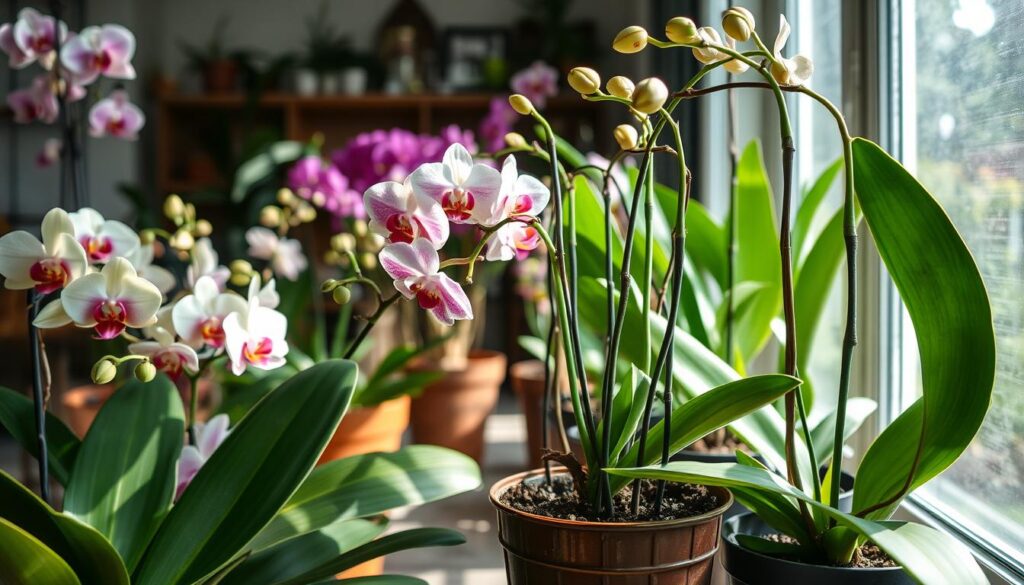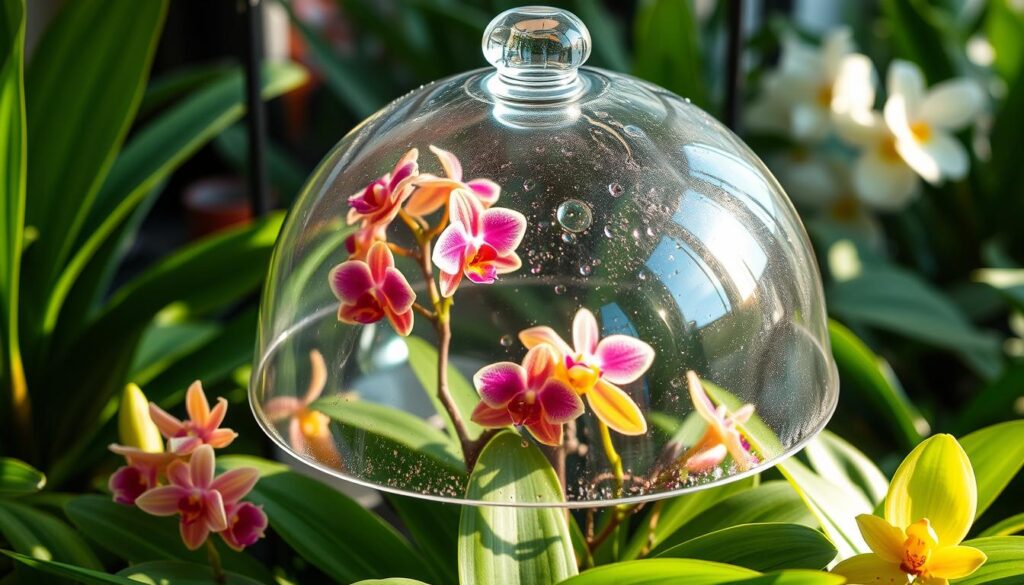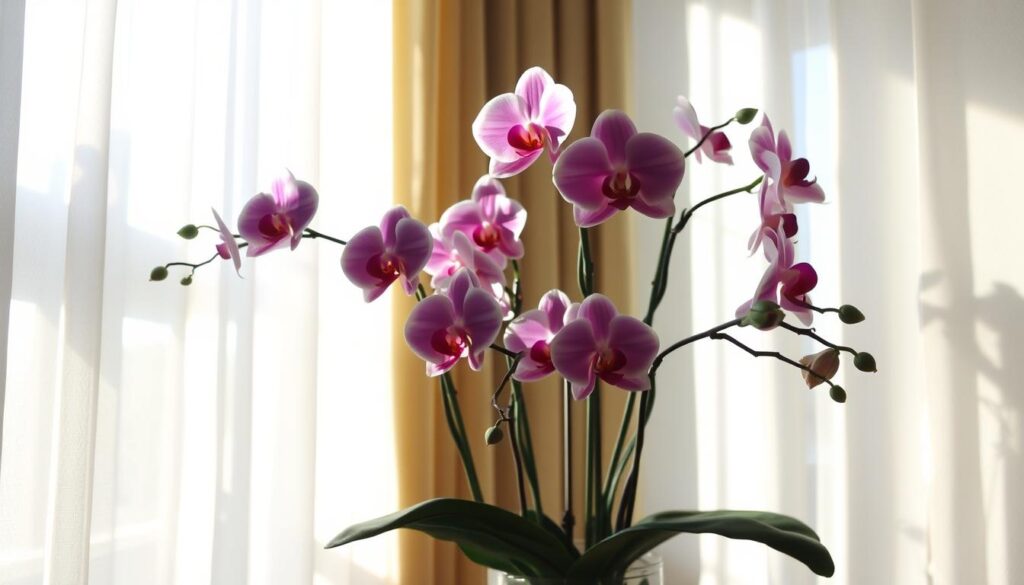Physical Address
304 North Cardinal St.
Dorchester Center, MA 02124
Physical Address
304 North Cardinal St.
Dorchester Center, MA 02124

Propagating orchids at home doesn’t have to be intimidating. Stem node propagation is a simple method to multiply your orchid collection. This guide will show you how to use stem nodes to grow new orchids easily.
You’ll learn to cultivate a thriving orchid oasis in your living space. We’ll walk you through each step of the process. Soon, you’ll be growing healthy, vibrant orchids at home.

Orchids offer a unique propagation experience for gardeners. Various methods are available for orchid propagation. Keiki propagation and division propagation are popular techniques with distinct advantages.
Orchid enthusiasts have several propagation methods to choose from. Each technique has its own benefits.
Stem node propagation is a rewarding and accessible method. It involves cultivating dormant stem nodes on an orchid. This technique stimulates new plant growth, expanding your orchid collection.
Stem node propagation preserves the parent plant’s genetic makeup. The new orchids will share the same desirable traits.
Timing is crucial for successful orchid propagation. The best time is during the plant’s active growth phase. This usually occurs in spring or early summer.
Propagating during this time aligns with the orchid’s natural cycle. It provides ideal conditions for new root growth and development.
The right tools and materials are key for successful orchid propagation at home. Careful selection and preparation of equipment ensure a smooth process. Let’s explore the must-have items for every orchid enthusiast.
Sharp, clean pruning shears and knives are vital for precise cuts on orchid stems. Choose high-quality tools that slice cleanly without damaging delicate tissues. Properly sterilized shears help prevent the spread of diseases or pests.
Applying a rooting hormone to cut stem nodes boosts propagation success. These hormones, like indole-3-butyric acid (IBA), promote root growth. Follow product instructions carefully for best results.
A well-draining, nutrient-rich potting medium is crucial for propagated orchid cuttings. Mix sphagnum moss with specialized orchid potting mix. This blend creates an ideal environment for root establishment and growth.
A clean workspace prevents harmful pathogens from affecting your propagated orchids. Prepare a sterilizing solution using diluted bleach or rubbing alcohol. Use this to disinfect tools and work surfaces before and during propagation.
| Tool or Material | Purpose | Recommended Features |
|---|---|---|
| Pruning Shears | Cutting and trimming orchid stems | Sharp, clean, and sterile blades |
| Rooting Hormone | Stimulating root growth on cuttings | IBA-based formula for optimal results |
| Sphagnum Moss | Providing a moist, well-draining medium | High-quality, long-fiber sphagnum moss |
| Sterilizing Solution | Disinfecting tools and work surfaces | Diluted bleach or rubbing alcohol mixture |
Gathering these essential tools sets you up for success in orchid propagation. With the right equipment, you’ll be ready to grow new plants from stem nodes.
Orchid propagation from stem nodes is a great way to grow your plant collection. Success hinges on finding viable nodes. Let’s explore how to spot healthy nodes for propagation.
Orchid stems have unique anatomy. Recognizing signs of healthy nodes is key. This knowledge will boost your chances of successful propagation.
Orchid nodes are spots where leaves and aerial roots grow. A good node for propagation looks swollen and plump. It has a dormant bud ready to sprout new growth.
Healthy nodes are usually bright green. They feel firm when touched. These traits indicate a node’s readiness for propagation.
| Healthy Nodes | Unhealthy Nodes |
|---|---|
| Plump, swollen appearance Vibrant green color Firm to the touch Visible dormant bud | Shriveled, desiccated look Yellow, brown, or black discoloration Soft or mushy texture No visible dormant bud |
Examine your orchid’s stem nodes carefully. Look for the healthiest sections for propagation. Pay attention to these visual clues.
Choosing the right nodes boosts your chances of success. Your cuttings will have a better shot at rooting and thriving.
A sterile environment is vital for orchid propagation at home. Proper workspace setup prevents contamination and boosts success rates. Let’s look at how to create a clean propagation area.
Clean and disinfect your work surface thoroughly. Use a diluted bleach solution or commercial disinfectant to kill potential pathogens. Make sure the surface is completely dry before you begin.
Collect all necessary tools for your orchid propagation project. This includes clean scissors, a sharp knife, and a cutting board. You’ll also need a clean container or tray for the process.
Keep these items organized and within easy reach. This will help maintain efficiency during propagation.
Cover your work surface with clean, disposable paper or cloth. This creates a barrier and helps prevent contamination. It’s a simple step that greatly improves your sterile environment.
| Essential Items for Propagation Setup | Purpose |
|---|---|
| Disinfectant Spray or Solution | Sterilize work surface and tools |
| Clean, Sterile Scissors or Knife | Safely cut and handle plant material |
| Clean Container or Tray | Provide a sterile propagation vessel |
| Protective Paper or Cloth Cover | Create a barrier to prevent contamination |
These steps will set you up for successful orchid propagation at home. They’ll help minimize contamination risks throughout the process. With proper preparation, you’re ready to start growing new orchids.
Orchid propagation through stem node cuttings is easy and effective for home gardeners. This method helps multiply your orchid collection. You can create new plants from existing ones with the right techniques.
Successful stem node propagation requires careful execution of each step. Start by finding a healthy, mature stem on your orchid. Use a sharp, sterilized blade to make a clean cut below a viable node.
Ensure the cut is made at a 45-degree angle to maximize surface area for root development. This angle helps increase the chances of successful root growth.
The angle and precision of your cuts are crucial for successful node propagation. Always use a sharp, sterilized blade for clean cuts. Make straight cuts at a 45-degree angle to ensure the best results.
Avoid jagged or torn cuts to prevent introducing pathogens. These types of cuts can slow down the healing process.
Handle orchid stems with care to prevent damage during propagation. Wear gloves and work in a clean, well-ventilated area. This helps minimize the risk of contamination.
Discard any damaged or diseased plant material properly. This prevents the spread of pests and diseases to other plants.
These best practices for node cutting will help your orchids thrive. By using sterile techniques and proper stem care, you’ll create healthy new orchids.
Orchid propagation at home needs careful attention to the growing environment. Balancing humidity, temperature, and light is key for stem node cuttings. The right conditions foster strong roots and vibrant new growth.
A humidity dome or mini greenhouse helps maintain high humidity levels. Orchids love this moist environment. Use a well-draining propagation tray to avoid waterlogging the delicate roots.
Keep temperatures between 65°F to 80°F (18°C to 27°C) for healthy orchid growth. Sudden changes can stress the plants. Place your setup in a warm, stable area of your home.
Orchids need plenty of light, but direct sunlight can harm them. Partial shade or filtered light works best. A north-facing window or sheer curtain can provide ideal lighting conditions.
With the right setup, your orchid propagation project has a great chance of success. Soon, you’ll enjoy vibrant, healthy orchids grown from stem nodes.

| Optimal Growing Conditions | Range |
|---|---|
| Humidity | 60-80% |
| Temperature | 65°F to 80°F (18°C to 27°C) |
| Light Intensity | Partial shade or filtered light |
Choosing the right potting medium is key for successful orchid propagation from stem nodes. A good soil mix offers drainage, aeration, and moisture retention. These factors are vital for root growth and plant health.
A great potting medium for orchid node propagation blends orchid potting mix, sphagnum moss, perlite, and charcoal. This mix balances water retention, air flow, and nutrients. It supports delicate orchid cuttings as they root and grow.
Sterilize your potting mixture to remove pests or pathogens that could harm your orchid cuttings. You can bake the soil mix at 200°F (93°C) for 30 minutes. Another option is soaking ingredients in 10% bleach solution, then rinsing thoroughly.
| Ingredient | Proportion |
|---|---|
| Orchid potting mix | 50% |
| Sphagnum moss | 30% |
| Perlite | 15% |
| Charcoal | 5% |
Proper watering and humidity are vital for orchid stem node propagation. Balancing misting, humidity, and watering can greatly impact your new orchid cuttings’ growth. Careful management of these factors is crucial for success.
Avoid over-watering and under-watering your orchid cuttings. Water them every 2-3 days, letting the medium dry slightly between waterings. Adjust the schedule based on temperature and air circulation.
Orchids love humid environments, especially newly propagated stem nodes. Keep humidity at 60-80% to boost root growth and prevent dryness. Use a pebble tray, mist regularly, or create a greenhouse-like setup for moisture.
| Factor | Recommended Range |
|---|---|
| Watering Frequency | Every 2-3 days |
| Humidity Levels | 60-80% |
Monitor your orchid’s water and humidity needs closely. This attention creates an ideal growing environment for stem node propagation. Your extra care will ensure healthy, vibrant new orchid plants.
“The key to successful orchid propagation is finding the right balance between moisture and air circulation.”
Proper temperature and lighting are vital for orchid stem node propagation. These factors can make or break your new plants’ growth. Balancing them correctly is key to successful propagation.
Research your specific orchid’s temperature needs. Most orchids thrive in 65-85°F (18-29°C) daytime temperatures. At night, they prefer 55-65°F (13-18°C).
Sudden temperature shifts can stress orchid stems and hinder propagation. Use temperature control devices to keep a stable environment for your orchids.
The right temperature and lighting boost your orchid propagation success. Your efforts will pay off with healthy, thriving new plants.

Propagating orchids at home can be rewarding. But, it’s vital to avoid common pitfalls. These mistakes can ruin your success.
Here are key errors to avoid during propagation:
Avoid these pitfalls to boost your chances of success. Stay alert and your orchids will thrive. Your propagation journey can be a great success!
Propagating orchids from stem nodes is thrilling. It’s vital to watch growth stages closely. This ensures your new plants flourish.
Each milestone is significant. From initial root growth to new leaf signs, every step matters.
Expect to see root growth 2-4 weeks after cutting stem nodes. These tiny roots will slowly extend. They form the base for your plant’s future.
Be patient and provide ideal conditions. The initial rooting phase is crucial for success.
Tracking root growth and new leaf development helps assess propagation success. It allows you to adjust the growing environment if needed.
“Patience and attention to detail are the keys to successful orchid propagation from stem nodes.”
Stay watchful and understand healthy growth timelines. This boosts your chances of propagating vibrant orchids from existing plants.
Propagating orchids from stem nodes can be rewarding but challenging. Issues like pests and fungal infections may arise. Stay alert and take action to help your orchids thrive.
Orchid pests such as mealybugs, spider mites, or scale insects can stunt growth. They might also introduce diseases. Inspect your plants often and use safe, organic pest control methods.
Fungal infections can occur if growing conditions aren’t ideal. Watch for discoloration, wilting, or rotting. Isolate affected areas and apply fungicides when needed. Adjust your care routine if necessary.
Maintain proper humidity and air circulation to prevent fungal problems. These steps will create a healthier environment for your orchids to grow and flourish.
Stem node propagation is a simple way to grow your orchid collection. It’s cost-effective and produces healthy new plants. This method also helps maintain genetic diversity in your orchids.
Orchids can be grown using stem node, keiki, and division methods. Each technique suits different orchid species and growth stages. The choice depends on your orchid type and propagation goals.
Spring and summer are ideal for orchid propagation. These seasons match the orchids’ natural growth cycle. This timing provides the best conditions for root and leaf growth.
You’ll need sharp, sterilized pruning shears and rooting hormone. Sphagnum moss and sterile growing medium are also important. Set up a clean workspace to avoid contamination.
Look for plump, green nodes with visible dormant buds or growth points. These are often near the orchid’s base. Carefully inspect your plant to find these viable nodes for successful propagation.
Cut the node from the parent plant and treat it with rooting hormone. Then, plant it in sterile growing medium. Use proper cutting techniques and handle the stem carefully.
Maintain an optimal growing environment for the best results. This ensures the success of your propagation efforts.
Set up a space with the right humidity, temperature, and lighting. Use a humidity dome or mini greenhouse to maintain ideal conditions.
A propagation tray can also help create the perfect environment. These tools support the growth of newly propagated nodes.
Use a well-draining, airy, and sterilized potting mix. A blend of sphagnum moss, perlite, and charcoal works well.
This mixture promotes optimal root development and plant health. It provides the right balance of moisture and air for orchid nodes.
Balance watering, humidity, and light exposure for new nodes. Mist them regularly and maintain proper temperature ranges. Provide the right light intensity to support growth and development.
Avoid overwatering and poor sterilization. Use proper cutting techniques and protect nodes from pests and diseases. Follow propagation best practices closely.
Address any issues promptly to ensure successful orchid propagation. With care and attention, your new orchids will thrive.